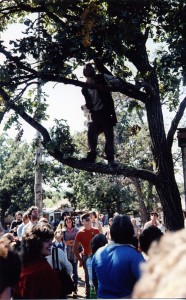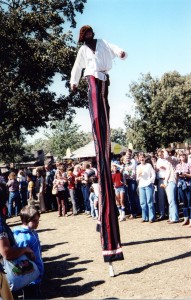UPDATE January 7, 2010: Representative comments follow, plus a followup observation from the writer of the original post. (I have disabled comments due to an avalanche of ‘spam’. My e-mail address is on the “About” page.)
Yesterday afternoon an e-mail announced that I was on YouTube. Since I’ve not been on YouTube before (at least to my knowledge), I rushed to the link. Indeed I was there, the last minute and a half or so.
When I opened the movie, there had been no views at all, not surprising since only my friend, Lynn Elling, and I, had received the e-mail announcing it. Besides, when the young man, who was one of the founders of YouTube in 2005 (and a few years earlier a student at St. Paul MN Central HS), put up the first link of himself at the San Diego Zoo, I suppose he was the first and among the very few viewers of that famous YouTube video, too. ( I looked just now, and there have been five viewers of my ‘show’; I doubt my performance will go viral, like Minnesota Wedding, with over 37,000,000 views since last summer, but one takes what fame one can get!)
The three of us who speak on the Dec. 21 video were at a local school, rededicating it as a peace site. Lynn Elling who founded World Citizen has campaigned against the horrors of war since he witnessed the aftermath during three years as a Naval Officer in the Pacific in WWII. He’s a hero of mine. Martha Roberts is current President of World Citizen.
I wasn’t listed among the speakers, but was called on near the end, and expounded for a bit on a disconnect I was feeling in the class room of 15 year olds.
The feeling came when Mr. Elling talked about a workshop that changed his life in the late 1940s. Leader Maxwell Maltz (Psychocybernetics) convinced Lynn, then a floundering insurance salesman about to quit the trade, that if he could visualize any goal “in three dimensions, technicolor and stereophonic sound”, that goal could come to life – and it did for Lynn, who became very successful in his financial products business.
But as I was listening to Lynn, along with the 30 15 year olds, it occurred to me most of those kids had no idea what, at minimum, “technicolor” or “stereophonic sound” were; and were it not for rare movies like the current Avatar, “3 dimension” (called 3D, of course) would be equally foreign to them. So, when I was unexpectedly given an opportunity to speak, that disconnect is what I expounded about. (Most of that portion is edited out, but the reference to computers also applies.)
Lynn was in college when I was born; 40 when I graduated from college. To those 15 year olds, mostly born in perhaps 1994, I realized I was well beyond ancient as well.
Their view and their vocabulary and their skill-sets are entirely different than those of myself, or Lynn, or Martha. More so than any time in history, Elders and Youngers have relatively few life experiences or expertise in common. We live in different worlds.
It is obvious, but too seldom considered, that there exists a big generation gap between today’s Elders, who care a lot about the future for the Youngers, and the Youngers themselves.
I tried to point out to the kids I was talking to that we want to help them achieve their future, but in reality, their future is in their hands, not ours. I was speaking from the emotion of the moment, without holding back.
We have to learn how to better communicate between generations.
We’ve got a long ways to go.
Take a look at me in the movies. Enjoy the show. It’s less than 5 minutes in all, 1 1/2 minutes of me, so no time for popcorn.
(Truth be told, I looked again at the Minnesota Wedding. Now that’s interesting!)
Comment from Carol Ashley Jan. 4, 2010: You said “their future is in their hands, not ours.”
I have often heard this at graduations and it bugs me. We’ve created their future by our own actions and we still (or did before the corporate takeover) have a lot of effect on the world. I think it wouldn’t hurt if we took our cues from younger folk as we age.
If we tell young people only that the future is in their hands, do they believe it? I doubt it. Or at least not totally. They’ve not had much power up to that point. If we say it’s in their hands and we want to help them make the kind of world they want to have, then we not only let them know they have to create their future but indicate we will help. This, I would think, would be more apt to motivate them. It also focuses on a communal effort.
Better communication between young and old and in between certainly needs improvement. I so often see parents and other adults minimizing teen experience…first love, first breakup…all that stuff. If we took them seriously at all ages and really listened to them, I think they might listen to us, too. It’s easy to minimize the experiences of youth, but if we examined ourselves, we could see that those experiences are part of what makes us who we are. They are formative (to use a psychological term) and therefore very important. So I think we need to start by respectful listening. I think that applies to the split in our country, too. It’s not an easy task to listen to some one of a different political persuasion, especially if what we hear seems so untrue, but it is the first step.
This is all on the micro level. You, Dick, often have talked about those incremental steps. I’m sure those steps are important. It just doesn’t seem like they can work fast enough for the crises we see in the world today which is why I’m not very hopeful. Still, I think those steps are important wherever and whenever we have the opportunity or can make the opportunity.
Comment from Judy Berglund January 5, 2010: I took a few minutes to review the video, and I think you guys are on to something. I wish your remarks hadn’t been edited. You recognize something that few in our generation recognize: that we aren’t talking to our kids enough and we aren’t doing enough to understand how they communicate. Our kids are idealistic, and we can tap into that idealism through efforts such as your presentation. They feel powerless, and we can empower them through such presentations. Let’s do more to understand them and to help them understand us. Here’s to YouTube!!!
Comment from Lynn Elling (the other man in the video) to the person who made the video January 4, 2010: WOW!!!
Dick: It has been most interesting to review these and other comments, including the most recent one from a good friend who’s a retired teacher: “I was trying to guess their interest. Sometimes older people don’t connect with younger students so I was curious about the interest level.”
I was more “primed” for this than usual, since only a few weeks earlier I’d been to an excellent all day workshop entitled “Coming Forth as Elders: Heartening Community with the Vision of Elderhood“, facilitated by Kaia Svien and Eric Utne. Thirty or more of us had a day to sit with this topic, most of us in my age range – some a little older, most a little younger….
My audience on Dec. 22 was 10th graders. Their next stop after my little talk was lunch. I taught 8th and 9th graders for nine years, years ago so I know the species. A rock star would have his or her work cut out…! But I didn’t see anybody “cutting and running”…they were polite and well behaved. Perhaps I was sufficiently passionate so that they wondered, “where is HE coming from?” As Judy mentioned, I, too, wish that the rest of what was said was on the DVD (about 5 minutes in all, I’d guess.) But probably it is best as it is, the rest of the remarks left to each imagination (including my own).
The DVD has helped, already, to lead to conversation.
There is a communication gap between youngers and elders these days that is far greater than in the good old days, when the youngers worked the farm with their parents and were blessed (or stuck) with an environment where everybody lived life in common. With variations, other environments were similar.
Today there is a canyon between elders and youngers. Acknowledging it, and talking about it is the step to resolution. It will be slow and difficult, but it needs to happen.
Our generation has left a mess for the youngers; and while I didn’t feel at all empowered when I was 15 (in 1955); at the same time a future was being held for me when I matured. Today we are truly “spending our kids inheritance”, shamelessly. They don’t have the luxury I did.
In the e-mail exchange with the classroom teacher, I learned about an important event happening in San Jose in late March. The details are here. Check it out. Don’t be terribly surprised if you hear from me about the conference, if I can figure a way to attend…. (Find the upcoming events box and take a look, and let others know about this opportunity.)




